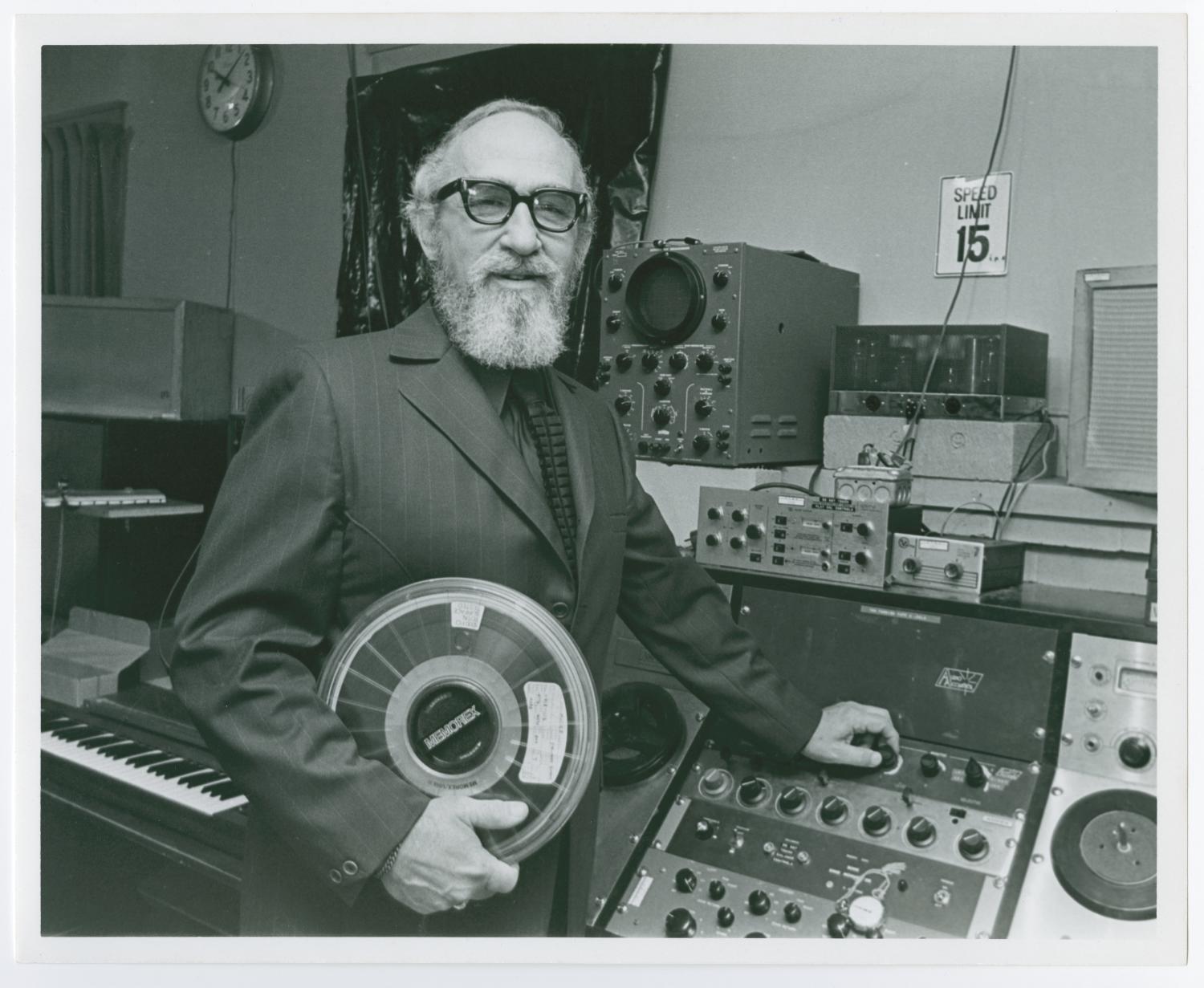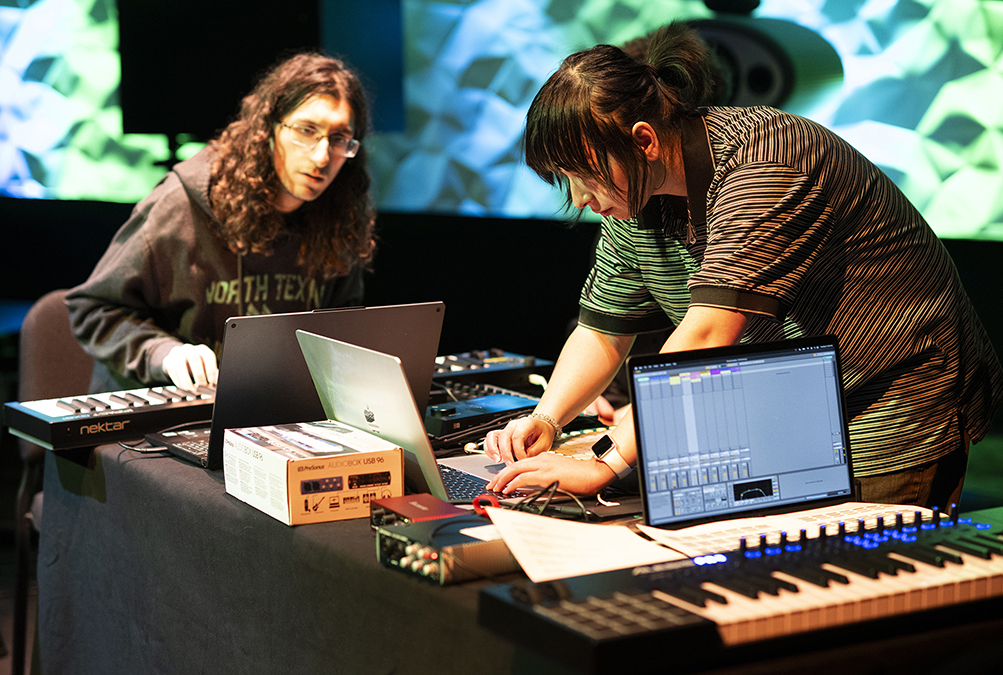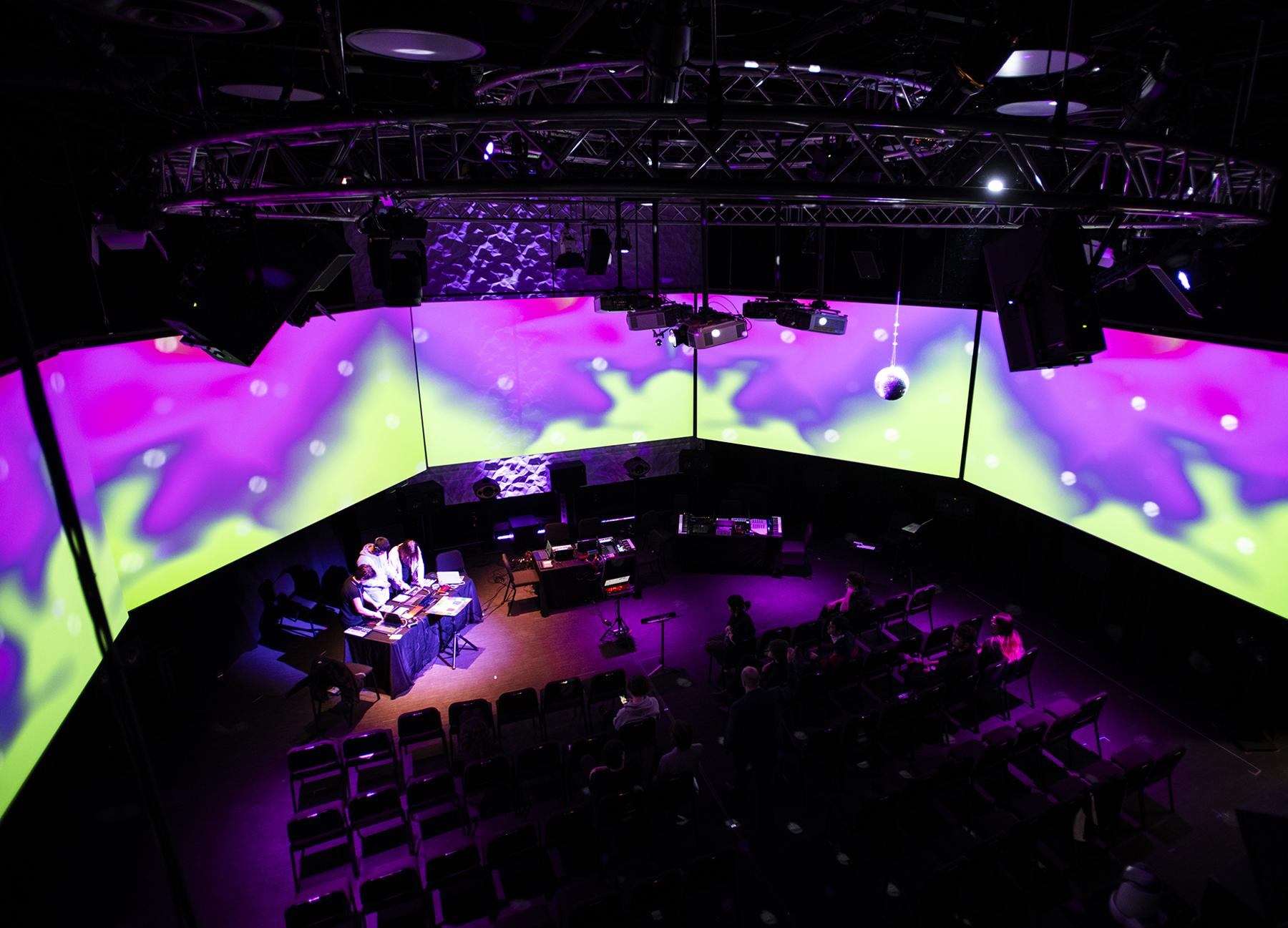Sight & Sound
March 4, 2024
UNT’s Center for Experimental Music and Intermedia celebrates six decades of exploring new frontiers in music and arts technologies.
BY LISA SCIORTINO
In a house on Mulberry Street in Denton, late faculty composer Merrill Ellis changed the face and future of music studies at UNT when in 1963 he established the Electronic Music Center, one of the first electronic music studios in the nation.

Photograph of Merrill Ellis holding a reel of tape near the synthesizer in the Electronic
Music Center. (Photo: UNT Special Collections)
For years, the space served as a haven for faculty and students who created and recorded in its tape music studio, which boasted some of the most technologically advanced recording equipment available at the time. Amid the sound boards and synthesizers – including inventor Robert Moog’s first portable synthesizer, designed in collaboration with Ellis – was an eclectic assortment of lights, lasers, projectors and electronics intended to enhance the music listening — and viewing — experience.
In the six decades since its founding, the center, now housed in the Music Building on the UNT campus and renamed the Center for Experimental Music and Intermedia (CEMI), produced countless hours of performance-based research and gained a world-renowned reputation. Today, CEMI’s breadth of research and artistic work from faculty and students spans across disciplines from fixed-media computer music to interactive performance and mixed reality.
“Ellis had the vision to do something that was different than anyone else was doing at the time,” says Jon Nelson, a professor of composition who previously served as CEMI’s director. “UNT embraced his vision, realizing this was a brave new frontier for music research and innovation.”
In its 60th year, CEMI is celebrating its trailblazing legacy while continuing to explore emerging possibilities in music and arts technologies.
Pioneering Work
CEMI’s contributions to experimental music and intermedia have been recognized around the world. From hosting internationally lauded guest artists and researchers to staging music conferences and festivals, UNT has nurtured important scholarly discussions and performances to advance the disciplines.
Among those were the 2000 national conference for the Society for Electro-Acoustic Music in the United States, the nation’s premier electroacoustic music organization, and UNT’s own CEMIcircles Festival in 2013 and 2017 through 2019, which showcased works by alumni, students and research affiliates, including Ellis. It also hosted the International Computer Music Conference in 1981 and again in 2015.
CEMI's commitment to innovation continues to drive these fields forward, leaving
a lasting impression on how we perceive and interact with sound.
Panayiotis Kokoras
“CEMI has been instrumental in pushing the boundaries of experimental music and intermedia,” says composition professor Panayiotis Kokoras, who has served as the center’s director since 2016. “Its commitment to innovation continues to drive these fields forward, leaving a lasting impression on how we perceive and interact with sound.”
An internationally award-winning composer and computer music innovator, Kokoras received the coveted John Simon Guggenheim Memorial Foundation fellowship in 2022 — as did his UNT College of Music colleague Sungji Hong, an assistant professor of composition. Kokoras says some of the most significant research contributions CEMI has made to experimental music and intermedia most recently have been within the field of 3D spatial sound.
This immersive audio technology creates a 3D soundscape around the listener by using multiple speakers to create a sense of distance and directionality for various sounds. It frequently is used to enhance the experiences of movies, music, games and other media, causing one to feel as though they’re in the middle of the action.
“The pioneering work in this area, facilitated by the Merrill Ellis Intermedia Theater (MEIT), has opened up new possibilities in various industries such as video games, cinema and home theater,” Kokoras says. “This advancement not only revolutionizes the auditory experience, but also has the potential to shape the future of audio technologies.”
An Unparalleled Space
The MEIT and CEMI’s four state-of-the-art studios, serve as labs and development spaces for students, faculty and guest artists in composition, electronics and related fields. “It is to a computer music composer what a Stradivarius violin is to a virtuoso. The sound quality, projection and precision here is unparalleled,” Kokoras says.
The black-box theater has undergone several significant renovation projects over the years – most recently in 2020 when an ambisonic “dome” (or hemisphere-like configuration) of 37 loudspeakers and two subwoofers was installed. It can create immersive soundscapes with tremendous precision and realism. Coupled with the MEIT’s five, 16-by-9-foot, acoustically transparent projection screens, dynamic lighting and live-automation capabilities, the theater serves as a catalyst for a variety of cutting-edge collaborations.
“We now have a theater that meets the most vigorous demands of people working in spatialized audio,” says Andrew May, an associate professor of composition who previously led CEMI for 13 years, the longest for any director thus far.
Best known for their instrumental works with live interactive computer systems, May is a composer, violinist, improvisor and computer musician. They celebrate the wide range of creative practices that come together in CEMI.
“It’s not just about creating an environment in the MEIT for people to create and share computer music of various kinds,” May says. “It’s also about creating and maintaining an environment that invites people to branch out, either through collaborations or by developing a more diversified portfolio of artistic and media skills of their own in other media.”
A Wonderful Lab
“There is a pretty deep appreciation for the space within CEMI,” says David Stout, a visual and sonic artist, composer and performer. The professor of composition studies also is affiliated with the College of Visual Arts and Design’s New Media Art program, which is focused on the relationship between technology, visual culture and performance in contemporary art. He coordinates the Initiative for Advanced Research in Technology and the Arts (iARTA) research network and works with faculty and students in the arts, sciences, engineering and technology.
Most years, Stout teaches the Intermedia Performance Art course, an interdisciplinary studio for advanced undergraduate and graduate students. The course concludes with a large-scale final performance staged in the MEIT. Stout and his students have created immersive installations, building environments that burst with hi-tech video, computer animation, electronic music, sculpture and other instruments and elements.

Students have access to a range of audio and visual equipment in the Merrill Ellis
Intermedia Theater. (Photo: Ahna Hubnik)
Such was the case in 2015, when the class presented nanoGalactic. It featured a type of “projection maze” that surrounded attendees with sights and sounds. These immersive environments provide important research opportunities and experiences for students as they prepare for careers in collaborative creative fields such as gaming, among others, Stout says. “It is a wonderful laboratory for exploring new technological possibilities.”
Stout is working with UNT Regents Professor Marco Buongiorno Nardelli, a composer, flutist, installation artist and computational physicist, to develop a small artificial intelligence-focused lab on campus where students may research the development of their own models of the technology to aid in the creation and performance of music compositions.
“AI is here to stay, and it is an amazing tool for creative people — scientists and artists, musicians, composers and filmmakers. But we need to own the technology, not just be users of the technology,” says Buongiorno Nardelli, who is dually appointed in both the Department of Physics and the College of Music Division of Composition Studies.
An Environment of Interactions
A fellow of the American Physical Society and the Institute of Physics, Buongiorno Nardelli has studied and performed music since childhood. He melds the two in his composition practice, which is based heavily on computational techniques.

The Merrill Ellis Intermedia Theater is host to faculty and student performances throughout
the year. (Photo: Ahna Hubnik)
During Spring 2022, Buongiorno Nardelli taught a course on data sonification, which focused on the use of data as raw materials for the music composition process. As part of the course, he and CEMI students collaborated with video artist Gábor Kitzinger of Hungary and renowned data scientist and visual artist Albert-László Bárabási, a professor at Northeastern University. The course culminated in an installation that spent two months on exhibit at the Ludwig Museum in Budapest. It has since been shown at numerous other venues in Europe and the U.S.
“The collaboration exemplifies the broad, interdisciplinary approach to making music, understanding music, performing music that really is at the core of CEMI,” Buongiorno Nardelli says. “The center allows students and faculty members to experiment with ideas that you wouldn’t be able to experiment with anywhere else. It’s an environment of people. It’s an environment of interactions. Just a single question from one person can spark a line of research that may go on for months.” Or, for that matter, decades.
As CEMI looks toward its future, Kokoras says its faculty and students will continue to stand as torchbearers of Merrill Ellis’ pioneering spirit.
“We uphold his legacy by relentlessly exploring uncharted territories, welcoming cutting-edge technologies and fostering connections with diverse fields of knowledge. We embrace the ever-evolving landscape of music and arts technology, driving forward into unexplored realms.”